
The Puerta de Alcalá is a Neo-classical gate in the Plaza de la Independencia in Madrid, Spain.
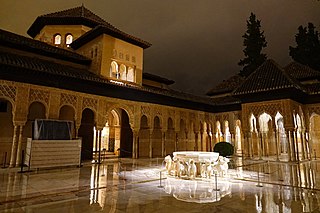
The Court of the Lions (Spanish: Patio de los Leones; Arabic: بهو السباع) is the main courtyard of the Palace of the Lions in the heart of the Alhambra, the Moorish citadel formed by a complex of palaces, gardens and forts in Granada, Spain. It was commissioned by the Nasrid sultan Muhammed V of the Emirate of Granada in Al-Andalus. Its construction started in the second period of his reign, between 1362 and 1391 AD. The site is now part of the UNESCO World Heritage List and minted in Spain's 2011 limited edition of 2 € Commemorative Coins.
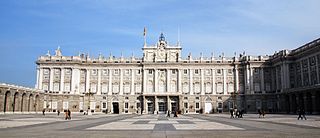
Spanish architecture refers to architecture in any area of what is now Spain, and by Spanish architects worldwide. The term includes buildings which were constructed within the current borders of Spain prior to its existence as a nation, when the land was called Iberia, Hispania, or was divided between several Christian and Muslim kingdoms. Spanish architecture demonstrates great historical and geographical diversity, depending on the historical period. It developed along similar lines as other architectural styles around the Mediterranean and from Northern Europe, although some Spanish constructions are unique.

Pedro de Ribera was a Spanish architect of the Baroque period.
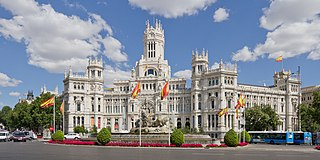
Cibeles Palace, formally known as Palacio de Comunicaciones and Palacio de Telecomunicaciones until 2011, is a complex composed of two buildings with white facades and is located in one of the historical centres of Madrid, Spain. Formerly the city's main post office and telegraph and telephone headquarters, it is now occupied by Madrid City Council, serving as the city hall, and the public cultural centre CentroCentro.

The architecture of Madrid has preserved the look and feel of many of its historic neighbourhoods and streets, even though Madrid possesses a modern infrastructure. Its landmarks include the Royal Palace of Madrid, the Royal Theatre with its restored 1850 Opera House, the Buen Retiro Park, the 19th-century National Library building containing some of Spain's historical archives, a large number of national museums, and the Golden Triangle of Art located along the Paseo del Prado and comprising three art museums: Prado Museum, the Reina Sofía Museum, and the Thyssen-Bornemisza Museum, which completes the shortcomings of the other two museums. Cibeles Palace and Fountain have become the monument symbol of the city.

The Battle of Bayona Islands, also known as the Battle of Bayona Bay, was a naval engagement that took place in early 1590, off Bayona Islands, near Bayona and Vigo, Spain, between a small Spanish naval force commanded by Captain Don Pedro de Zubiaur, and an Anglo-Dutch flotilla of 14 ships, during the Eighty Years' War, and in the context of the Anglo-Spanish War (1585–1604) and the French Wars of Religion. After several hours of hard combat, the Spanish naval force composed of three flyboats achieved a great success, and the Anglo-Dutch fleet was totally defeated. The flagship of the Dutch was boarded and captured, including another six ships more. Finally, the rest of the Dutch fleet was forced to surrender. Shortly after, Pedro de Zubiaur arriving at Ferrol, along with the captured ships, with great surprise for the Spanish authorities of the port.

The Fountain of la Abundancia, or Fuente de la Abundancia, was located in the Plaza de la Cebada in Madrid, for this plaza also was known by this name. It has retained several architectural elements and various coats of arms, which were saved from demolition work which took place in the 19th century, to be integrated into a new structure.

Malasaña is an area in the centre of Madrid, Spain. It does not correspond to any administrative division, but it is often conflated with Universidad, the wider administrative neighborhood on which Malasaña is located. The webpage providing touristic information published the Madrid City Council set as limits the streets of San Bernardo, the Gran Vía, Fuencarral and Carranza. Malasaña is associated with a creative and counter-cultural scene.

The Fountain de La Mariblanca was a fountain located in Puerta del Sol, in Madrid. Now demolished. Not to be confused with other fountains located in Madrid and Spain with the same name.

Maurism was a conservative political movement that bloomed in Spain from 1913 around the political figure of Antonio Maura after a schism in the Conservative Party between idóneos and mauristas ('maurists'). Its development took place in a period of crisis for the dynastic parties of the Spanish Restoration regime. The movement, which fragmented in several factions in the 1920s, has been portrayed as a precursor of the Spanish radical right.
Andres Rossi was a Spanish artist. He worked as a painter, draughtsman, print maker, sculptor and writer in Madrid and Seville.
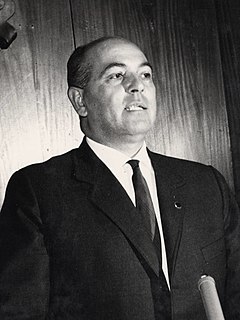
José Solís Ruiz was a Spanish politician, known for his role in Francoist Spain, during which he occupied a number of important posts.

Eduardo González Calleja is a Spanish historian, professor of Contemporary History at the Charles III University of Madrid (UC3M). He is the author of a long list of scholar works dealing with political violence.

The plaza de Pedro Zerolo is a public square located in the centre of Madrid, Spain.

The Plaza de Isabel II is a historic public square between the Sol and Palacio wards in the central district of Madrid. The plaza is at the convergence of Arenal Street and the minor roads Arrieta, Calle de Campomanes, Caños del Peral, Escalinata and Vergara. It was formed by filling the ravine created by the Arenal stream and the source of the Fountain of the Canals of the Pear Tree. The square occupies part of the site where the old Theater of the Caños del Peral stood between 1738 and 1817.

Pedro Montoliú Camps is a Spanish journalist who was named a Chronicler of the Villa de Madrid in 1999.
In the Cárcel Modelo massacre, at the outset of the Spanish Civil War, a group of anarchist militiamen occupied the Madrid prison on August 22, 1936, and killed about 30 politicians and soldiers held there. Following rumors that the prisoners—suspected political and military supporters of the 1936 military uprising—were escaping, an angry throng assembled at the prison's gates and demanded the execution of the "fascists". A group of anarchist militiamen took control of the prison and that night executed well-known politicians and soldiers. The reputation of the republican government faltered from its inability to quell the crowd and protect the prisoners. The incident sparked protests from the diplomatic corps in Madrid.
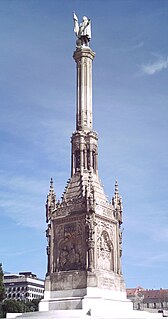
The Monument to Columbus is a monument in Madrid, Spain. It lies on the namesake square, the Plaza de Colón. The basement of the monument is a Gothic revival work by Arturo Mélida while the topping statue is a work by Jerónimo Suñol.
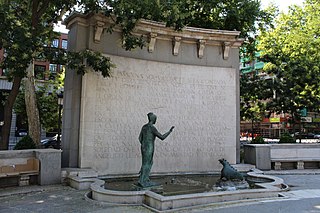
The Monument to Eugenio d'Ors Rovira is an instance of public art in Madrid, Spain. Dedicated to Eugenio d'Ors—noted Catalan writer, art critic and Francoist intellectual—it consists of a sculptural group put inside a fountain and a commemorative wall displaying a relief of d'Ors. It lies at the middle of the Paseo del Prado, facing both the Casa Sindical and the Prado Museum.

![A 1864 photograph of the fountain by Alfonso Begue [es], then located at the Plaza de Anton Martin. Alfonso Begue-Fuente Anton Martin-1864.jpg](http://upload.wikimedia.org/wikipedia/commons/thumb/e/e0/Alfonso_Begu%C3%A9-Fuente_Ant%C3%B3n_Mart%C3%ADn-1864.jpg/225px-Alfonso_Begu%C3%A9-Fuente_Ant%C3%B3n_Mart%C3%ADn-1864.jpg)

















